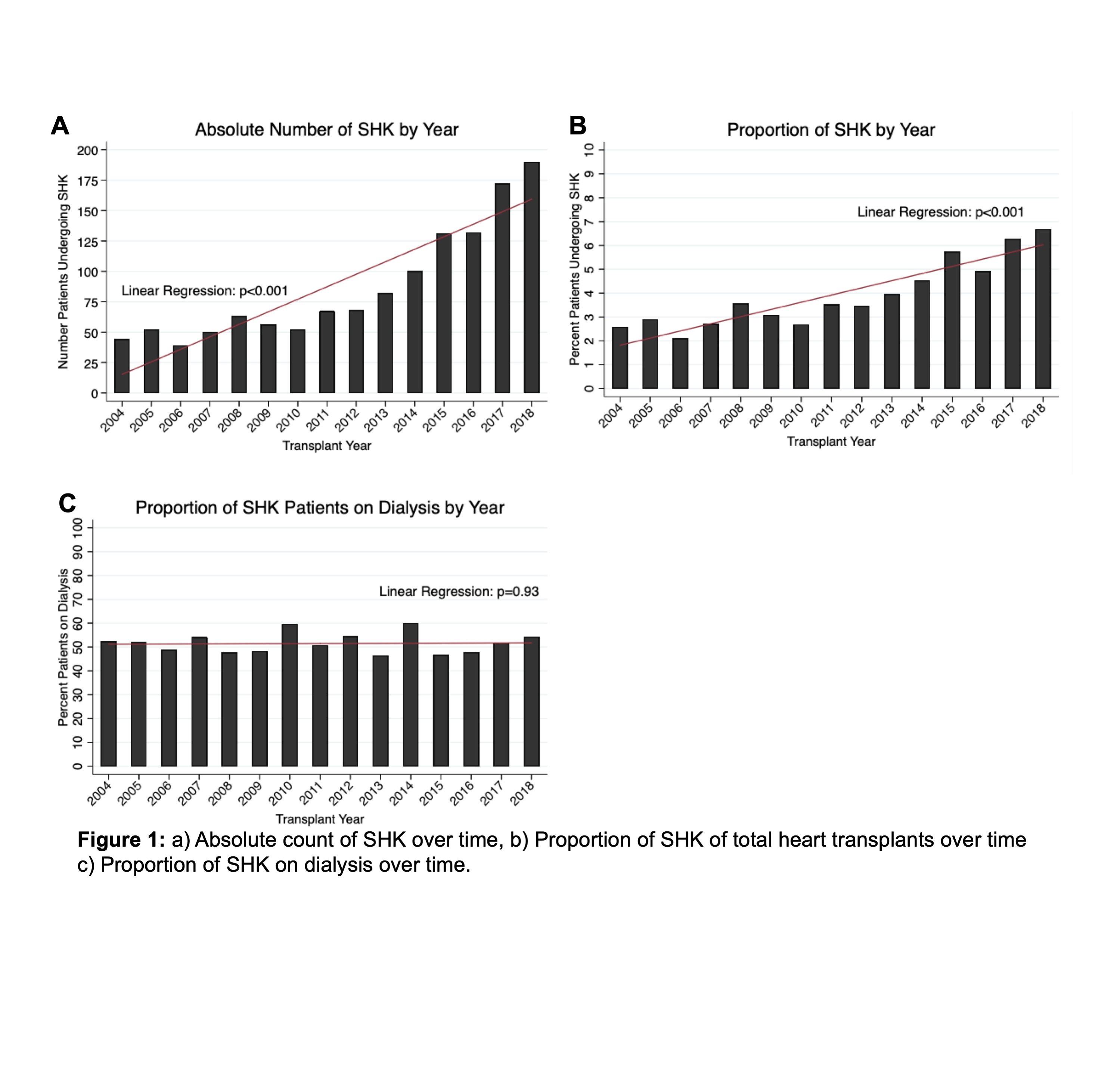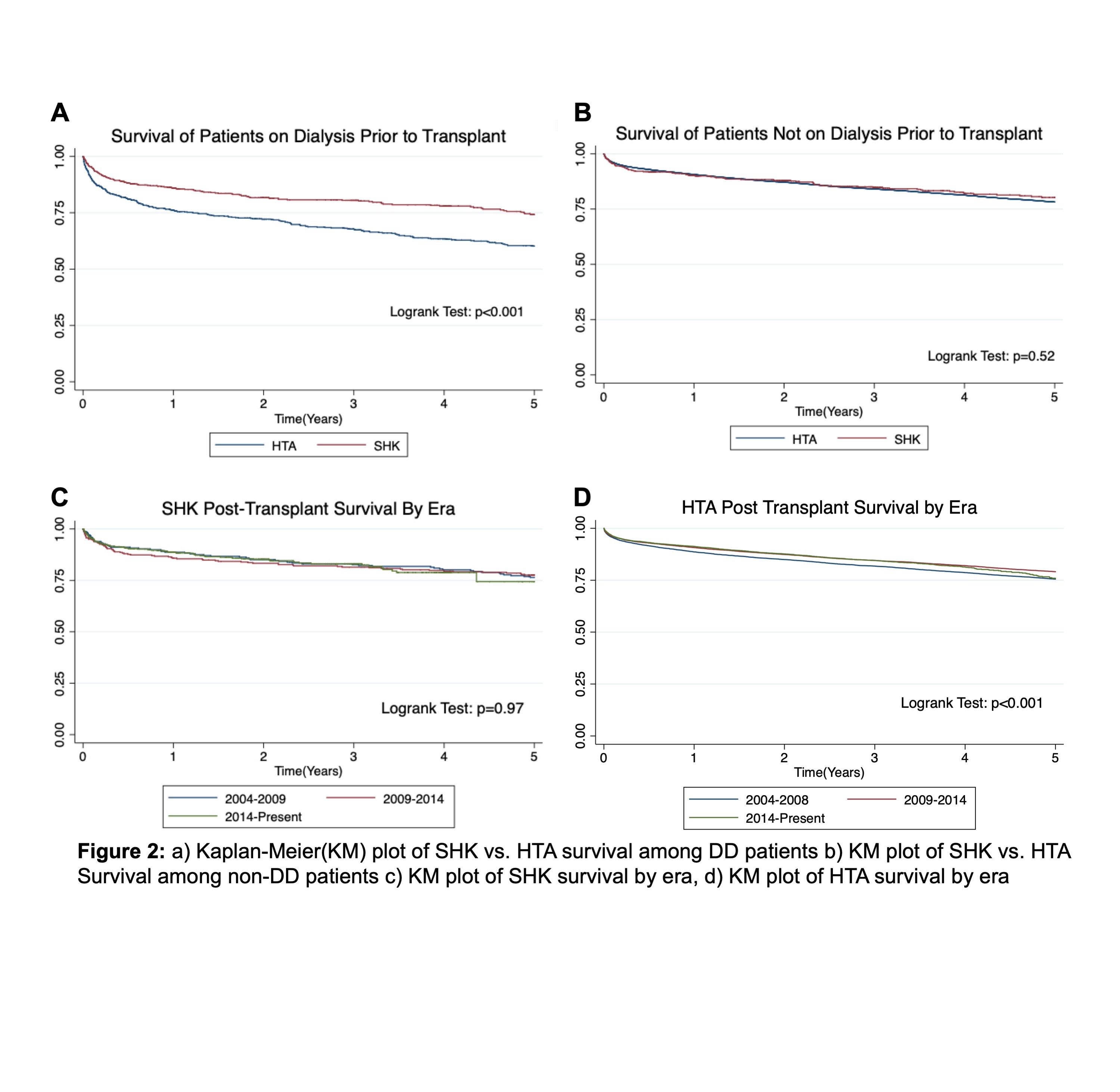Simultaneous Heart Kidney Transplant Benefits are Concentrated in the Dialysis Dependent Population
1Surgery, Duke University, Durham, NC, 2Medicine, Duke University, Durham, NC
Meeting: 2020 American Transplant Congress
Abstract number: 439
Keywords: Allocation, Heart transplant patients, Kidney transplantation, Outcome
Session Information
Session Name: All Organs: Public Policy & Allocation
Session Type: Oral Abstract Session
Date: Saturday, May 30, 2020
Session Time: 3:15pm-4:45pm
 Presentation Time: 4:03pm-4:15pm
Presentation Time: 4:03pm-4:15pm
Location: Virtual
*Purpose: With ongoing growth of simultaneous organ transplant and increased attention to allocation policy, we examined trends in simultaneous heart-kidney (SHK) transplantation outcomes over the last 15 years.
*Methods: The UNOS STAR file was queried for SHK and heart transplant alone (HTA) from 1/1/2004 to 1/1/2019. Recipients <18 years, other multiorgan transplants, and re-transplants within the analysis period were excluded. Unadjusted patient survival analysis was stratified by SHK and dialysis dependence (DD). Transplant outcomes were compared across 3 eras: 2004-2009, 2009-2014, and 2014-2019. Cox-proportional hazards stratified by DD were calculated.
*Results: During the study period, 1298 SHK and 30166 HTA transplants were performed. Though the absolute number and proportion SHK increased during the study period, the proportion proportion of SHK that were DD was unchanged (Figure 1 a-c). SHK recipients were older, more likely male, Black, and DD (Table 1). Unadjusted analysis showed significant benefit for SHK in the DD group only (Figure 2 a-b). This effect persisted following adjustment: among DD patients, SHK recipients had a decreased hazard of death compared to HTA (HR 0.59 95% CI 0.47-0.73). Non-DD patients did not demonstrate the same benefit (SHK vs. HTA HR 0.93 95% CI 0.76-1.13). Donor age and transplant year were also correlated with hazard of death in both models; recipient BMI was correlated in the DD only model; black race was correlated in the non-DD model. There was a small improvement in HTA but not SHK survival by era (Figure 2c-d).
*Conclusions: SHK in DD patients confers a significant survival benefit compared to HTA. Further work is necessary to clarify the subpopulation of non-DD patients who would benefit most from a SHK.
| Characteristic | SHK (n=1298) | HTA (n=30166) | p-value | DD (n=1417) | Non-DD (n=30047) | p-value |
| Sex-Female-n(%) | 262(20) | 7751(26) | <0.0001 | 321(23) | 7692(26) | <0.0001 |
| Age-Med(IQR) | 57(49-63) | 56(46-62) | 0.0001 | 54(44-61) | 56(46-63) | <0.0001 |
| Race-n(%)
Asian
Black
Hispanic
Other
Mixed
White
|
55(3) 394(30)
109(8)
5(1)
18(1)
717(55)
|
952(4)
6024(20)
2416(8)
182(1)
158(1)
20434(68)
|
<0.0001 |
61(4)
388(27)
134(9)
22(2)
6(1)
806(57)
|
946(3)
6030(20)
2391(8)
178(1)
157(1)
20345(68)
|
<0.0001 |
| BMI-Med (IQR) | 27(23-30) | 27(24-31) | 0.0002 | 27(23-30) | 27(24-31) | 0.091 |
| Dialysis-n(%) | 669(52) | 748(2) | <0.0001 | N/A | N/A | N/A |
| Life Support at Transplant-n(%) | 747(58) | 17593(58) | 0.58 | 889(63) | 17451(58) | 0.001 |
| Donor Age-n(%) | 29(22-40) | 30(22-41) | 0.90 | 29(22-40) | 30(22-41) | 0.15 |
To cite this abstract in AMA style:
Shaw BI, Samoylova ML, Fitch ZW, Bishawi M, Schmitz R, Kesseli SJ, Barbas AS, Patel CB, Sanoff SL, McElroy LM. Simultaneous Heart Kidney Transplant Benefits are Concentrated in the Dialysis Dependent Population [abstract]. Am J Transplant. 2020; 20 (suppl 3). https://atcmeetingabstracts.com/abstract/simultaneous-heart-kidney-transplant-benefits-are-concentrated-in-the-dialysis-dependent-population/. Accessed December 24, 2025.« Back to 2020 American Transplant Congress


